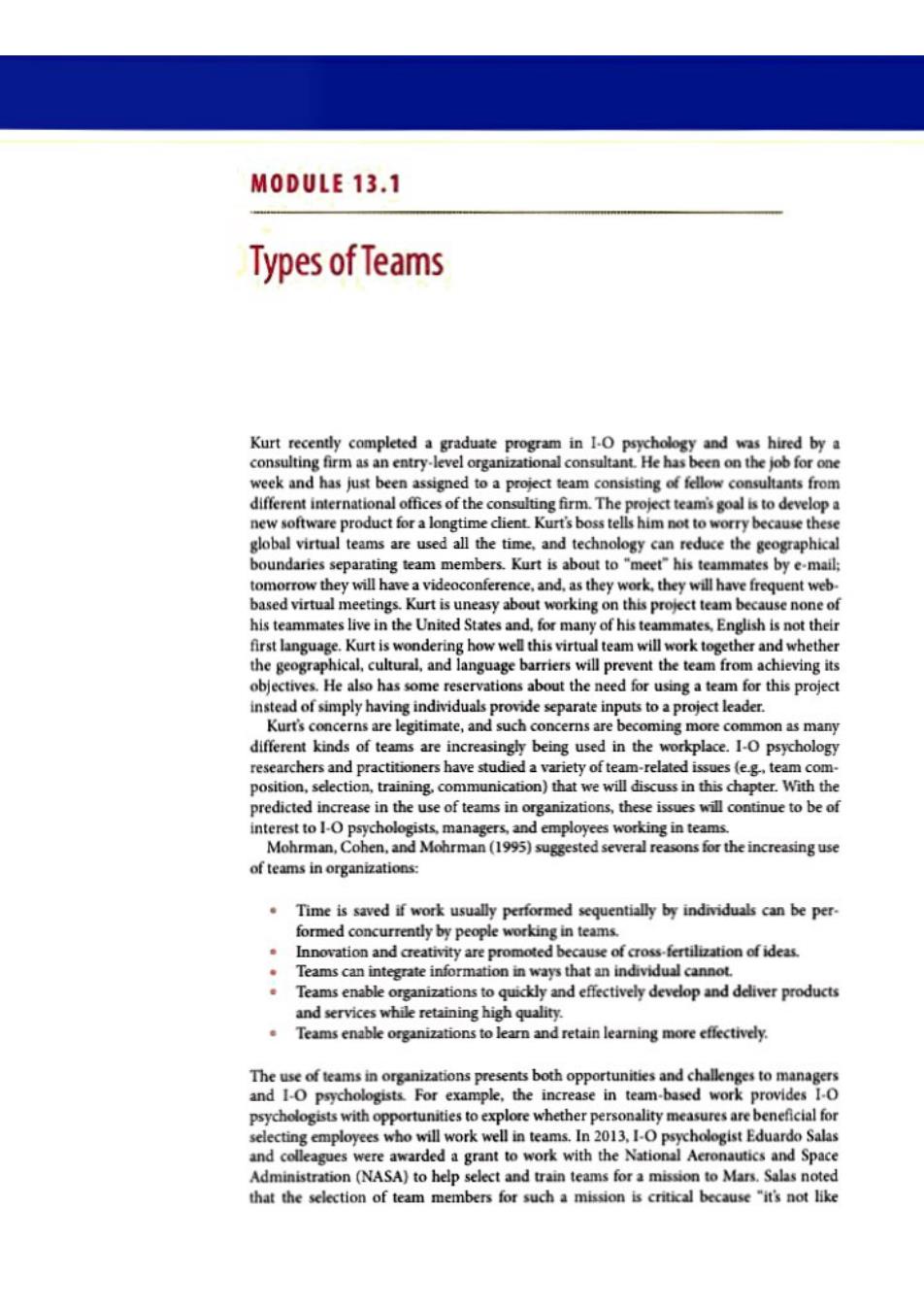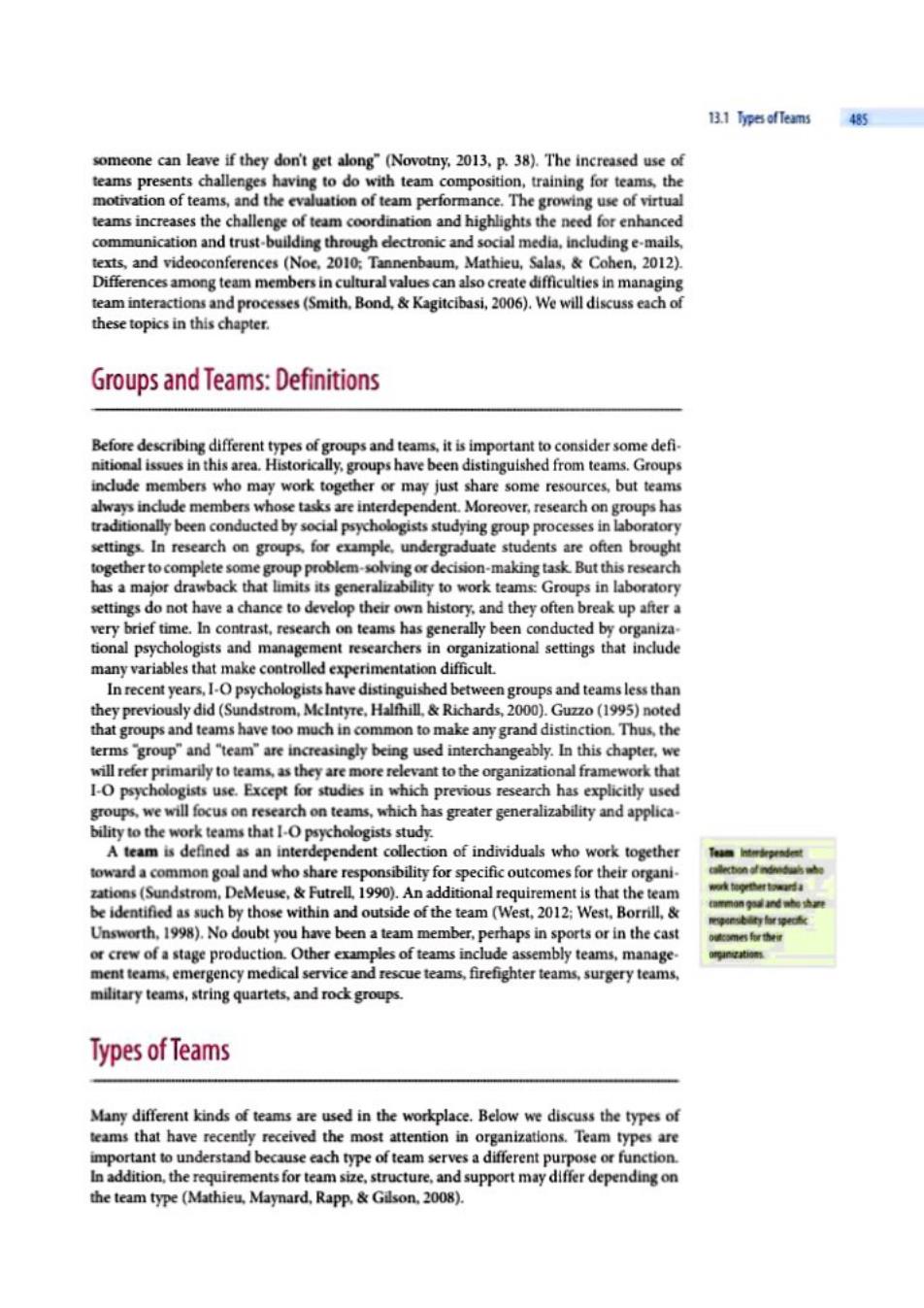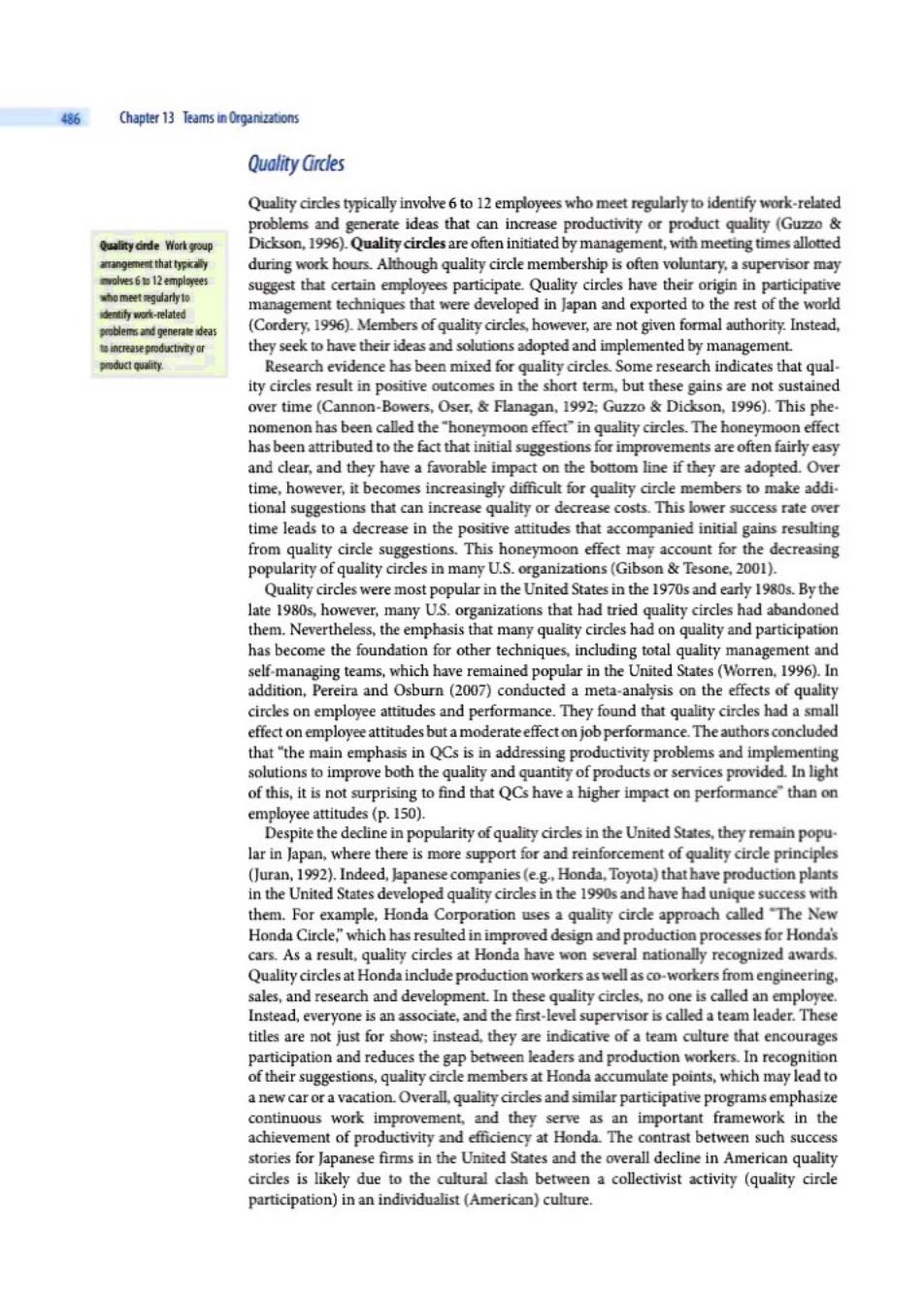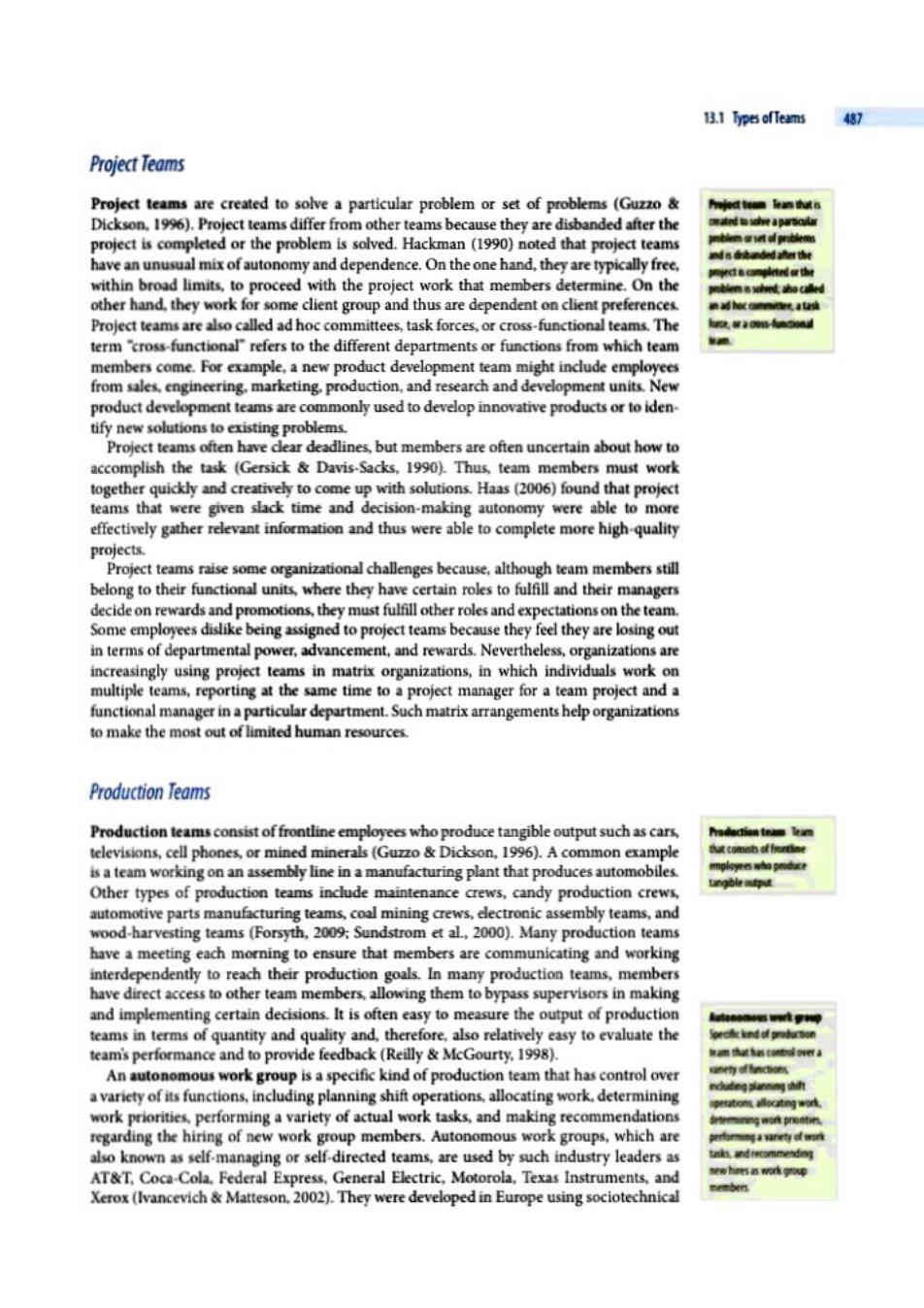
13 Teams in Organizations Module 13.1 Types of Teams 484 Module 13.3 Special lssues Groups and Teams:Definitions 485 in Teams 503 lypes of Teams 485 Team Appraisal and Feedback 503 Module 13.2 Input-Process-Output Team Roles 505 Model of Team Effectiveness 492 Team Development 506 Team inputs 493 Team Training 506 leam Processes 4% Cultural Issues in Teams 507 Team Outputs 500

MODULE 13.1 Types of Teams Kurt recently completed a graduate program in I-0 psychology and was hired by a consulting firm as an entry-level organizational consultant.He has been on the job for one week and has just been assigned to a project team consisting of fellow consultants from different international offices of the consulting firm.The project team's goal is to develop a new software product for a longtime client.Kurt's boss tells him not to worry because these global virtual teams are used all the time.and technology can reduce the geographical boundaries separating team members.Kurt is about to "meet"his teammates by e-mail; tomorrow they will have a videoconference,and,as they work,they will have frequent web. based virtual meetings.Kurt is uneasy about working on this project team because none of his teammates live in the United States and,for many of his teammates,English is not their first language.Kurt is wondering how well this virtual team will work together and whether the geographical,cultural,and language barriers will prevent the team from achieving its objectives.He also has some reservations about the need for using a team for this project instead of simply having individuals provide separate inputs to a project leader. Kurt's concerns are legitimate,and such concerns are becoming more common as many different kinds of teams are increasingly being used in the workplace.I-0 psychology researchers and practitioners have studied a variety of team-related issues (eg.team com- position,selection,training.communication)that we will discuss in this chapter.With the predicted increase in the use of teams in organizations,these issues will continue to be of interest to 1-O psychologists,managers,and employees working in teams. Mohrman,Cohen,and Mohrman(1995)suggested several reasons for the increasing use of teams in organizations: Time is saved if work usually performed sequentially by individuals can be per. formed concurrently by people working in teams. Innovation and creativity are promoted because of cross-fertilization of ideas. Teams can integrate information in ways that an individual cannot. Teams enable organizations to quickly and effectively develop and deliver products and services while retaining high quality. Teams enable organizations to learn and retain learning more effectively. The use of teams in organizations presents both opportunities and challenges to managers and 1-0 psychologists.For example,the increase in team-based work provides I-O psychologists with opportunities to explore whether personality measures are beneficial for selecting employees who will work well in teams.In 2013,I-O psychologist Eduardo Salas and colleagues were awarded a grant to work with the National Aeronautics and Space Administration (NASA)to help select and train teams for a mission to Mars.Salas noted that the selection of team members for such a mission is critical because "it's not like

13.1 Types ofTeams 485 someone can leave if they don't get along"(Novotny,2013,p.38).The increased use of teams presents challenges having to do with team composition,training for teams,the motivation of teams,and the evaluation of team performance.The growing use of virtual teams increases the challenge of team coordination and highlights the need for enhanced communication and trust-building through electronic and social media,including e-mails. texts,and videoconferences (Noe,2010:Tannenbaum,Mathieu,Salas,Cohen,2012). Differences among team members in cultural values can also create difficulties in managing team interactions and processes(Smith.Bond,Kagitcibasi,2006).We will discuss each of these topics in this chapter. Groups and Teams:Definitions Before describing different types of groups and teams,it is important to consider some defi- nitional issues in this area.Historically,groups have been distinguished from teams.Groups include members who may work together or may just share some resources,but teams always include members whose tasks are interdependent.Moreover,research on groups has traditionally been conducted by social psychologists studying group processes in laboratory settings.In research on groups,for example,undergraduate students are often brought together to complete some group problem-solving or decision-making task But this research has a major drawback that limits its generalizability to work teams:Groups in laboratory settings do not have a chance to develop their own history.and they often break up after a very brief time.In contrast,research on teams has generally been conducted by organiza. tional psychologists and management researchers in organizational settings that include many variables that make controlled experimentation difficult. In recent years,I-O psychologists have distinguished between groups and teams less than they previously did(Sundstrom,Mclntyre.Halfhill,&Richards,2000).Guzzo(1995)noted that groups and teams have too much in common to make any grand distinction.Thus,the terms group"and "team"are increasingly being used interchangeably.In this chapter,we will refer primarily to teams,as they are more relevant to the organizational framework that 1-0 psychologists use.Except for studies in which previous research has explicitly used groups,we will focus on research on teams,which has greater generalizability and applica- bility to the work teams that I-O psychologists study. A team is defined as an interdependent collection of individuals who work together toward a common goal and who share responsibility for specific outcomes for their organi. zations (Sundstrom,DeMeuse,Futrell,1990).An additional requirement is that the team be identified as such by those within and outside of the team (West,2012:West,Borrill, mon and whe sha Unsworth,1998).No doubt you have been a team member,perhaps in sports or in the cast or crew of a stage production.Other examples of teams include assembly teams,manage. ment teams,emergency medical service and rescue teams,firefighter teams,surgery teams, military teams,string quartets,and rock groups. Types of Teams Many different kinds of teams are used in the workplace.Below we discuss the types of teams that have recently received the most attention in organizations.Team types are important to understand because each type of team serves a different purpose or function. In addition,the requirements for team size,structure,and support may differ depending on the team type (Mathieu,Maynard,Rapp,Gilson.2008)

485 Chapter 13 Teams inOrganizations Quality Grcles Quality cirdles typically involve 6 to 12 employees who meet regularly to identify work-related problems and generate ideas that can increase productivity or product quality (Guzzo Quality drde Work group Dickson,1996).Quality circles are often initiated by management,with meeting times allotted angeme城that typically during work hours.Although quality circle membership is often voluntary.a supervisor may molves6l2empl与eegs suggest that certain employees participate.Quality circles have their origin in participative aome时gularly to deniy work-related management techniques that were developed in Japan and exported to the rest of the world blems and generate deas (Cordery,1996).Members of quality circles,however,are not given formal authority.Instead, increase productivty or they seek to have their ideas and solutions adopted and implemented by management. roduct quality. Research evidence has been mixed for quality circles.Some research indicates that qual. ity circles result in positive outcomes in the short term,but these gains are not sustained over time (Cannon-Bowers,Oser,Flanagan,1992;Guzzo Dickson,1996).This phe- nomenon has been called the "honeymoon effect"in quality circles.The honeymoon effect has been attributed to the fact that initial suggestions for improvements are often fairly easy and clear,and they have a favorable impact on the bottom line if they are adopted.Over time,however,it becomes increasingly difficult for quality circle members to make addi- tional suggestions that can increase quality or decrease costs.This lower success rate over time leads to a decrease in the positive attitudes that accompanied initial gains resulting from quality cirdle suggestions.This honeymoon effect may account for the decreasing popularity of quality circles in many U.S.organizations(Gibson Tesone,2001). Quality circles were most popular in the United States in the 1970s and early 1980s.By the late 1980s,however,many US.organizations that had tried quality circles had abandoned them.Nevertheless,the emphasis that many quality cirdes had on quality and participation has become the foundation for other techniques,including total quality management and self-managing teams,which have remained popular in the United States (Worren,1996).In addition,Pereira and Osburn (2007)conducted a meta-analysis on the effects of quality circles on employee attitudes and performance.They found that quality circles had a small effect on employee attitudes but a moderate effect on job performance.The authors concluded thatthe main emphasis in QCs is in addressing productivity problems and implementing solutions to improve both the quality and quantity of products or services provided.In light of this,it is not surprising to find that QCs have a higher impact on performance"than on employee attitudes (p.150). Despite the decline in popularity of quality cirdes in the United States,they remain popu- lar in Japan,where there is more support for and reinforcement of quality circle principles (Juran,1992).Indeed,Japanese companies(e.g.Honda,Toyota)that have production plants in the United States developed quality circles in the 1990s and have had unique success with them.For example,Honda Corporation uses a quality circle approach called"The New Honda Circle,which has resulted in improved design and production processes for Honda's cars.As a result,quality cirdles at Honda have won several nationally recognized awards. Quality circles at Honda include production workers as well as co-workers from engineering. sales,and research and development.In these quality circles,no one is called an employee. Instead,everyone is an associate,and the first-level supervisor is called a team leader.These titles are not just for show;instead,they are indicative of a team culture that encourages participation and reduces the gap between leaders and production workers.In recognition of their suggestions,quality circle members at Honda accumulate points,which may lead to a new car or a vacation.Overall,quality cirdes and similar participative programs emphasize continuous work improvement,and they serve as an important framework in the achievement of productivity and efficiency at Honda.The contrast between such success stories for Japanese firms in the United States and the overall decline in American quality cirdles is likely due to the cultural clash between a collectivist activity (quality circle participation)in an individualist (American)culture

13.1 Types ofTeams 487 Project Teams Project teams are created to solve a particular problem or set of problems (Guzzo Dickson,1996).Project teams differ from other teams because they are disbanded after the project is completed or the problem is solved.Hackman (1990)noted that project teams ded the have an unusual mix of autonomy and dependence.On the one hand,they are typically free. within broad limits,to proceed with the project work that members determine.On the om nsived.she caled other hand,they work for some client group and thus are dependent on client preferences. 热转hem线aad Project teams are also called ad hoc committees,task forces,or cross-functional teams.The .oit-hnmona term cross-functional"refers to the different departments or functions from which team members come.For example,a new product development team might include employees from sales,engineering.marketing.production,and research and development units.New product development teams are commonly used to develop innovative products or to iden- tify new solutions to existing problems. Project teams often have dlear deadlines,but members are often uncertain about how to accomplish the task (Gersick Davis-Sacks,1990).Thus,team members must work together quickly and creatively to come up with solutions.Haas (2006)found that project teams that were given slack time and decision-making autonomy were able to more effectively gather relevant information and thus were able to complete more high-quality projects. Project teams raise some organizational challenges because,although team members still belong to their functional units,where they have certain roles to fulfill and their managers decide on rewards and promotions,they must fulfill other roles and expectations on the team. Some employees dislike being assigned to project teams because they feel they are losing out in terms of departmental power,advancement,and rewards.Nevertheless,organizations are increasingly using project teams in matrix organizations,in which individuals work on multiple teams,reporting at the same time to a project manager for a team project and a functional manager in a particular department.Such matrix arrangements help organizations to make the most out of limited human resources. Production Teams Production teams consist of frontline employees who produce tangible output such as cars, televisions,cell phones,or mined minerals(Guzzo Dickson,1996).A common example is a team working on an assembly line in a manufacturing plant that produces automobiles. Other types of production teams include maintenance crews,candy production crews, automotive parts manufacturing teams,coal mining crews,electronic assembly teams,and wood-harvesting teams(Forsyth,2009:Sundstrom et al,2000).Many production teams have a meeting each morning to ensure that members are communicating and working interdependently to reach their production goals.In many production teams,members have direct access to other team members,allowing them to bypass supervisors in making and implementing certain decisions.It is often easy to measure the output of production teams in terms of quantity and quality and,therefore.also relatively easy to evaluate the team's performance and to provide feedback(Reilly McGourty,1998). wam thae has cantsol over a An autonomous work group is a specific kind of production team that has control over e倚nc a variety of its functions,including planning shift operations,allocating work.determining work priorities,performing a variety of actual work tasks,and making recommendations regarding the hiring of new work group members.Autonomous work groups,which are also known as self-managing or self-directed teams,are used by such industry leaders as AT&T,Coca-Cola.Federal Express,General Electric,Motorola,Texas Instruments,and w西酒tae Xerox(lvancevich Matteson,2002).They were developed in Europe using sociotechnical